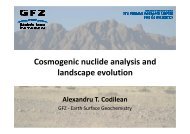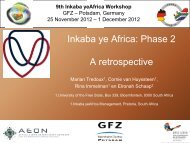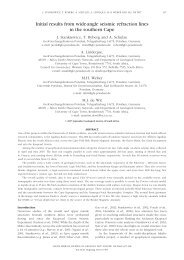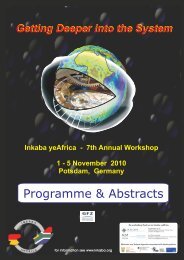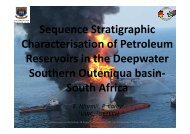Mandea et.al. - The magnetic field changing over
Mandea et.al. - The magnetic field changing over
Mandea et.al. - The magnetic field changing over
- TAGS
- mandea
- magnetic
- inkaba.org
You also want an ePaper? Increase the reach of your titles
YUMPU automatically turns print PDFs into web optimized ePapers that Google loves.
200<br />
THE MAGNETIC FIELD CHANGING OVER THE SOUTHERN AFRICAN CONTINENT<br />
Figure 7. Map of the tot<strong>al</strong> <strong>field</strong> intensity for epoch 2005, computed from the CHAOS model. <strong>The</strong> South Atlantic Anom<strong>al</strong>y is well defined<br />
by its weaker <strong>field</strong> v<strong>al</strong>ues. <strong>The</strong> track of the minimum of this anom<strong>al</strong>y <strong>over</strong> the last four centuries is shown by the green (GUFM) and yellow<br />
(CHAOS) lines with white labels indicating the approximate year. Sever<strong>al</strong> nearby magn<strong>et</strong>ic observatories are highlighted in red (HUA -<br />
Huancayo, VSS - Vassouras, TRW - Trelew, TSU - Tsumeb, HBK - Hartebeesthoek, HER - Hermanus). Units nT.<br />
south-east, centre, and south-west parts of the continent<br />
(Figure 4).<br />
From the examination of the geomagn<strong>et</strong>ic series<br />
provided by the three southern African observatories,<br />
the intriguing observation is made that the date of<br />
change in the declination trend coincides with that of a<br />
well-documented geomagn<strong>et</strong>ic jerk (<strong>Mandea</strong> <strong>et</strong> <strong>al</strong>.,<br />
2000). This simple observation, evident in Figure 3,<br />
brings to light new questions about geomagn<strong>et</strong>ic jerks<br />
and their role on sm<strong>al</strong>l spati<strong>al</strong> sc<strong>al</strong>es. More<strong>over</strong>,<br />
considering two European observatories (Chambon-la-<br />
Forêt and Niemegk) separated by a comparable distance<br />
as the two southern African ones (Tsumeb and<br />
Hermanus), makes it possible to underline the<br />
different behaviour b<strong>et</strong>ween these two regions<br />
(Figure 5). Chambon-la-Forêt and Niemegk show the<br />
same tempor<strong>al</strong> changes, whereas Tsumeb and<br />
Hermanus change dramatic<strong>al</strong>ly in declination behaviour<br />
after 1980.<br />
A recent model, CHAOS (Olsen <strong>et</strong> <strong>al</strong>., 2006),<br />
c<strong>over</strong>ing more than 6.5 years, brings important<br />
improvements in describing the secular variation from<br />
solely satellite data. Indeed, secular variation, no longer<br />
considered just linear, has its non-linear time changes<br />
described by means of splines in order to avoid<br />
unreasonable v<strong>al</strong>ues near the limits of the time interv<strong>al</strong>.<br />
This model <strong>al</strong>lows us to estimate the changes in the<br />
geomagn<strong>et</strong>ic <strong>field</strong> during the last few years, without any<br />
biases introduced by data qu<strong>al</strong>ity or by various<br />
approaches in modelling. Figure 6 illustrates the secular<br />
SOUTH AFRICAN JOURNAL OF GEOLOGY<br />
variation of the radi<strong>al</strong> <strong>field</strong> at the Earth’s surface<br />
obtained from this model. <strong>The</strong> radi<strong>al</strong> <strong>field</strong> is shown here,<br />
as this component and its secular variation are the ones<br />
expressed at the top of the core in order to infer outer<br />
core fluid motion.<br />
South Atlantic Anom<strong>al</strong>y.<br />
It is in this region that the shielding effect of the<br />
magn<strong>et</strong>ic <strong>field</strong> is severely reduced, thus <strong>al</strong>lowing high<br />
energy particles of the hard radiation belt to pen<strong>et</strong>rate<br />
deep into the upper atmosphere to <strong>al</strong>titudes below<br />
100 km. <strong>The</strong> region has an impact for spacecraft orbiting<br />
at sever<strong>al</strong> hundred km <strong>al</strong>titude with inclinations<br />
b<strong>et</strong>ween 35° and 60°, as they are exposed to sever<strong>al</strong><br />
minutes of strong radiation on each orbit. <strong>The</strong> South<br />
Atlantic Anom<strong>al</strong>y (SAA) is clearly observed when the<br />
magn<strong>et</strong>ic <strong>field</strong> intensity is computed from satellite<br />
measurements. Once more, the CHAOS model is used,<br />
and Figure 7 shows that the magn<strong>et</strong>ic <strong>field</strong> is becoming<br />
gener<strong>al</strong>ly weaker in this specific region. To find out how<br />
this anom<strong>al</strong>y has changed in time, we <strong>al</strong>so plot in<br />
Figure 7 the location of the minimum of the magn<strong>et</strong>ic<br />
<strong>field</strong> intensity in time. <strong>The</strong> v<strong>al</strong>ues computed here are<br />
based on two models, c<strong>over</strong>ing various time-spans: 1590<br />
to 1990 from the GUFM model (Jackson <strong>et</strong> <strong>al</strong>., 2000) and<br />
1999 to 2005 from the CHAOS model (Olsen <strong>et</strong> <strong>al</strong>.,<br />
2006). <strong>The</strong> SAA minimum has moved <strong>over</strong> the last four<br />
centuries, from the southern African continent to South<br />
America, with a notable rate during the last few<br />
centuries.



